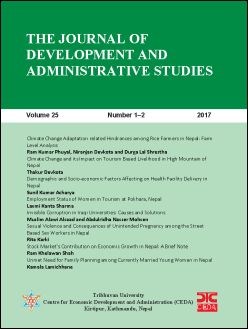Unmet Need for Family Planning among Currently Married Young Women in Nepal
DOI:
https://doi.org/10.3126/jodas.v25i1-2.23446Keywords:
Reproductive health, Contraception, Determinants, Regression analysis, NDHS dataAbstract
A high level of unmet need for contraception persists among currently married young women in Nepal. Evidences about unmet need for family planning and associated factors are not fully analyzed in the Nepalese context. Therefore, this study investigates the prevalence and determinants of unmet need for family planning among currently married young women in Nepal. This is an analytical cross-sectional study through secondary data analysis of the 2011 Nepal Demographic and Health Survey women data-file. The analysis is based on 2,552 currently married young women aged 15-24 years. Logistic regression is used to assess the net effect of independent variables on dependent variable. Women’s current age, number of living children, education level, occupation, women empowerment, caste/ethnic affiliation, and residence are independent predictors of unmet need. The odds of unmet need are significantly higher among the adolescents, rural, not empowered and not working young women. There is a need to strengthen income generating activities so as to improve their socio-economic status which will translate into female economic and social empowerment which enable them to discuss on sexual issues. Family planning programmes should be designed so as to address the unmet need of young women especially the rural adolescents.
Downloads
Downloads
Published
How to Cite
Issue
Section
License
The copyright of the accepted articles is reserved by the Centre for Economic Development and Administration (CEDA), Tribhuvan University (TU). No part of the article published in this journal should be reproduced except provided by the law currently in force without the written consent of the centre.




